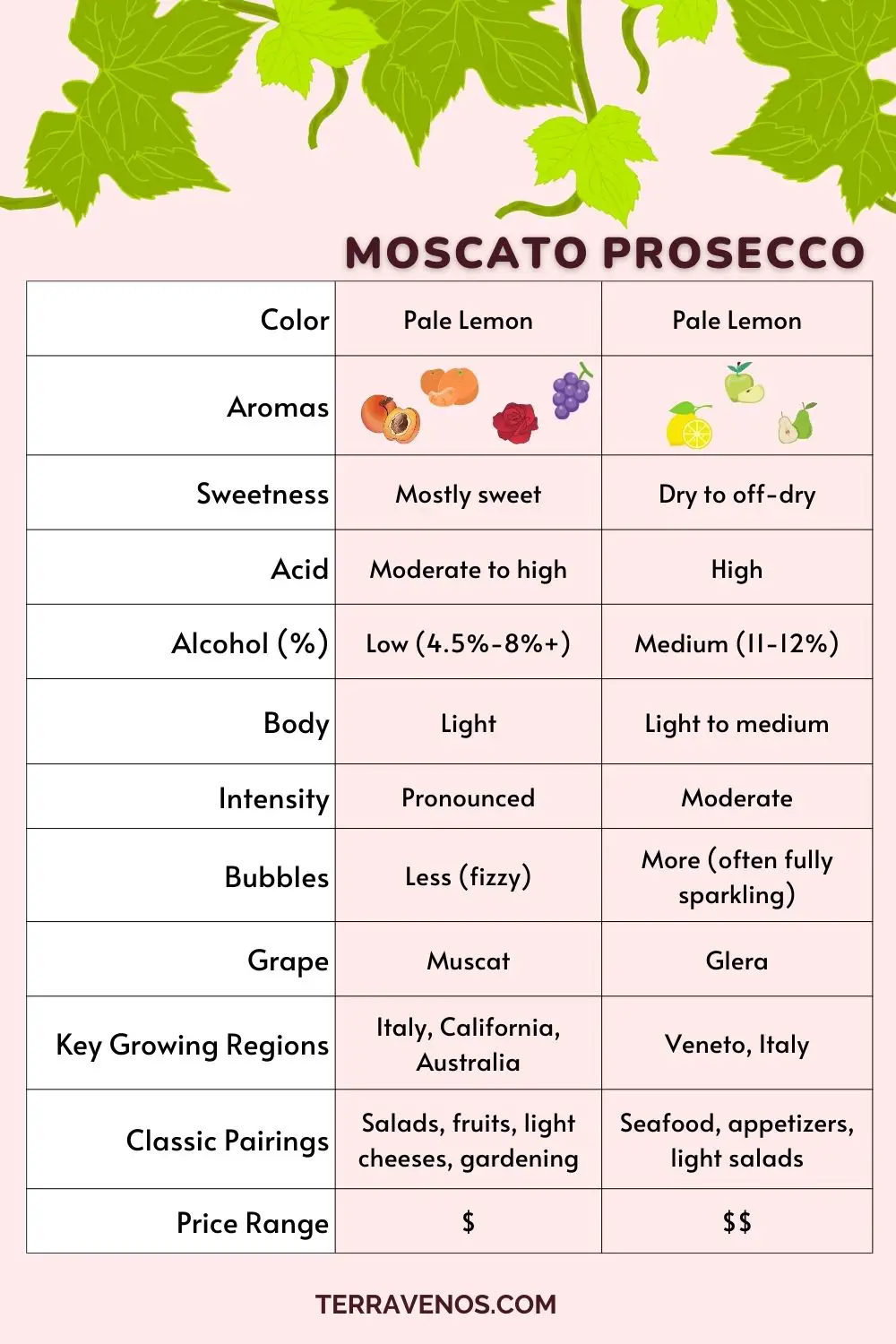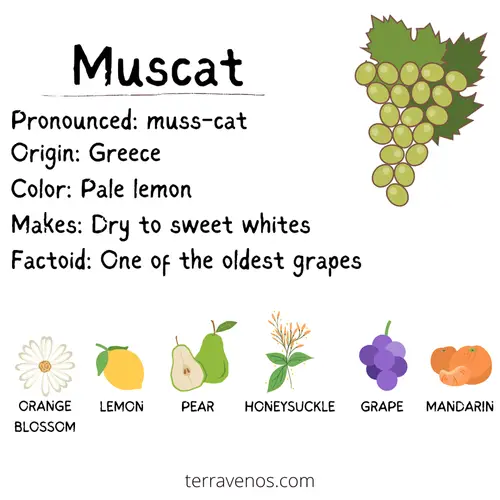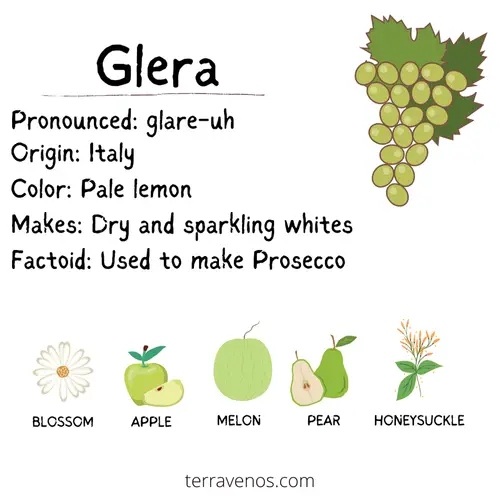
Choosing Moscato vs Prosecco is personal. Go for Moscato if you want a sweeter, less-fizzy, lower-alcohol wine (5-7% ABV). Choose Prosecco if you want a fizzier, drier wine with more alcohol (11%-12.5% ABV). Moscato is often less expensive than Prosecco, but both are affordable.
Here’s what you need to know when it comes to choosing Moscato vs Prosecco.
- What Is Moscato Wine?
- What Is Prosecco Wine?
- Moscato vs Prosecco: 6 Key Differences
- 1 Sweetness Levels: Moscato’s Sweeter than Most Proseccos
- 2 Alcohol Level: Prosecco Has Higher Alcohol than Moscato
- 3 Fizzyness: Prosecco Has More Fizz than Moscato
- 4 Grape Varieties: Glera and Muscat
- 5 Taste and Aromas: Moscato Is More Aromatic than Prosecco
- 6 Which Is More Expensive: Moscato vs Prosecco?
- Food Pairing with Moscato vs Prosecco
- Popular Moscato and Prosecco Brands
- Which Is Better Moscato or Prosecco?
- Final Thoughts – Moscato vs Prosecco
- Thirsty for More?
What Is Moscato Wine?

If you’re comparing Moscato and Prosecco, then you’re probably thinking about the light, sweetish white wine that has a slight effervescence to it. The most famous of this style of wine is Moscato d’Asti DOC, from Italy’s northwestern Piemonte region.
Jargon Alert: DOC stands for Denominazione di Origine Controllata (literally Controlled Designation of Origin), which is a demarcated region where a wine style comes from in Italy. Here are all of the Italian wine classifications explained (just in case you’re curious).
Moscato d’Asti, or just Asti, is made from a cultivar of Moscato grapes (there’s no actual grape called “Muscat”, which is unhelpful. The grape that makes your lovely fizzy Moscato is Moscato Bianco, or Muscat Blanc a Petit Grains, one of the most perfumed and aromatic of the Muscat family.
Helpful Tip: Here’s a rundown of everything you need to know about Muscat and its many versions.
What Is Prosecco Wine?

Also and Italian wine, Prosecco is a sparkling wine made in the Veneto region of Italy, almost directly east of Moscato d’Asti’s home, in the Veneto region (around where Romeo and Juliet met their doom). Just to confuse things, Prosecco isn’t a grape either, it’s the name of that sparkling wine you love. Prosecco is actually made from a white grape called Glera.
Prosecco is closely tied to its region of origin, with designations like Prosecco DOC and Prosecco DOCG ensuring quality and authenticity. These geographical indicators add a layer of prestige to every bottle of Prosecco.
Moscato vs Prosecco: 6 Key Differences
1 Sweetness Levels: Moscato’s Sweeter than Most Proseccos
Moscato wines are almost always sweeter than Prosecco. The winemakers stop fermentation early when Moscato is only around 5% ABV. The sweetness in your Moscato comes from the juice in the berry. Proseccos are almost always made in a dry or off-dry style. (Here’s more on why some wines are made in a sweet style).
Helpful Wine Buying Tip: If you see the words “demi-sec” on a bottle of Prosecco, it’s made in an off-dry style and will have some sweetness to it, but it will still seem less sweet than Moscato.
2 Alcohol Level: Prosecco Has Higher Alcohol than Moscato
Moscato typically features a lower alcohol by volume (ABV), hovering around 5-7%. This results in a sweeter profile, appealing to those who enjoy a milder kick. Conversely, Prosecco boasts a slightly higher ABV, ranging from 11-12%, contributing to its drier allure and providing a subtle but distinct potency for those seeking a crisper experience.
Personal Note: Moscato is my gardening wine. Its lower alcohol makes it a great sipping companion when you also want to stay sober.
3 Fizzyness: Prosecco Has More Fizz than Moscato
Prosecco is almost always more bubbly than Moscato. Prosecco comes in two styles: spumante (fully sparkling with a minimum of 3 atmospheres of pressure) or frizzante (1-2.5 atmospheres of pressure). Moscato made in the Asti style is almost always semi-sparkling, but you can find fully sparkling versions.
Helpful Wine Buying Tip: Want a fully sparkling Moscato? Look for Asti DOCG or Asti Spumante.
4 Grape Varieties: Glera and Muscat
As mentioned above, there’s no such thing as a “Muscat Grape”, but Muscat cultivars, like Moscato Bianco, are perfumed and highly aromatic. Glera, the grape used in Prosecco, isn’t as aromatic as Moscato and will be less layered with floral and perfume notes. Inexpensive Proseccos will have diluted aromas and flavors.
5 Taste and Aromas: Moscato Is More Aromatic than Prosecco
Moscato wines have a huge fanbase thanks to their aromatic and perfumed profile. You’ll get orange blossom, honey, perfume, and even grapey aromas in your Moscato. Prosecco is mainly citrus with medium intensity on the nose.
Prosecco will taste livelier in your mouth thanks to more bubbles, however, so that’s fun!
6 Which Is More Expensive: Moscato vs Prosecco?
Moscato is less expensive than Prosecco, but both are very affordable. You’ll find inexpensive to mid-priced wine Moscatos (starting around $5-$8 USD). Prosecco is mid-priced to premium-priced (starting around $15 USD).
Food Pairing with Moscato vs Prosecco

Moscato Pairings
- Pasta Dishes:
- Fettuccine Alfredo
- Lemon Garlic Shrimp Linguine
- Pesto Genovese with Sun-Dried Tomatoes
- Cheeses:
- Creamy Brie
- Aged Gouda
- Gorgonzola Dolce
- Italian Cuisine:
- Eggplant Parmesan
- Osso Buco
- Risotto Milanese
Bubble Bath Bombs: If you’re feeling adventurous, try pairing Moscato with your favorite bubble bath bombs for a truly effervescent experience – add some candles and feel decadent. Psst… always take care drinking wine in hot tubs and baths. You’ll dehydrate more quickly.
Prosecco Pairings
- Fish and Seafood:
- Grilled Lemon Butter Salmon
- Seafood Paella
- Oysters Rockefeller
- Cured Meats and Antipasto:
- Prosciutto-Wrapped Melon
- Caprese Skewers
- Marinated Artichoke Hearts
- Salads:
- Arugula and Prosciutto Salad with Fig Vinaigrette
- Watermelon and Feta Salad
- Spinach and Strawberry Salad with Balsamic Glaze
Popcorn with a Twist: Elevate your movie night by pairing Prosecco with popcorn drizzled with truffle oil. The bubbly and savory combination will tantalize your taste buds.
Pairings that Don’t Work: Moscato vs Prosecco
Typically, Moscato and Prosecco don’t work with sweet desserts. Pairing sweet dishes with wine is a challenge. Moscato isn’t a full dessert wine, even though it’s sweet. You can pair it with fresh fruit, and that’s about it. Prosecco won’t taste good with sweet dishes.
Helpful Wine Pairing Tip: Check out this food and wine flavor pairing quick guide for more on why pairing wine and desserts is a pain in the a$$.
Popular Moscato and Prosecco Brands
Renowned Moscato Producers
- Barefoot Cellars Moscato: Known for its approachable sweetness and vibrant fruitiness.
- Ecco Domani Moscato: Captures the essence of Italian Moscato with floral and peach notes.
Recognizable Prosecco Brands and Their Offerings
- La Marca Prosecco: Celebrated for its consistent quality and crisp, clean taste.
- Mionetto Prosecco: A well-balanced Prosecco with a fruit-forward profile.
Which Is Better Moscato or Prosecco?
If you prefer sweeter, lower alcohol, or more aromatic wines, than Moscato is the better choice. If you like fully sparkling, citrusy, higher-alcohol wines with lively bubbles, then Prosecco is a better wine. If you’re on a budget, Moscato is a better option.
Wine Buying Tip: The next time you’re at a restaurant, take a look at their wine menu. It will always have a Prosecco as a less-expensive sparkling wine alternative to Champagne (And no, Prosecco isn’t just cheap Champagne.)
Final Thoughts – Moscato vs Prosecco
Honestly, I personally like Moscato more than Prosecco, and I don’t think I’m alone. I’ve asked four newer acquaintances what styles of wines they enjoy in the past several weeks and each one said “Moscato”. I think Moscato’s popular because it’s a friendly, easy-drinking wine that has lots of flavor.
Prosecco’s dryer style makes it less approachable for the average drinker. And if you really want a dryer style of sparkling wine, then go for something a little more complex, like a Cava, and call it a day. Still, Prosecco is my go-to single-serving sparkling wine when I dine alone at restaurants and want a little fizz.
So, Moscato or Prosecco? It’s up to you!
Thirsty for More?
The best way to learn about different wine styles is to host DIY wine tastings. Grab similarly priced Moscato and Prosecco and get your taste on!
Love Moscato? Here’s a list of other sweet white wines that you’ll probably enjoy, too.




